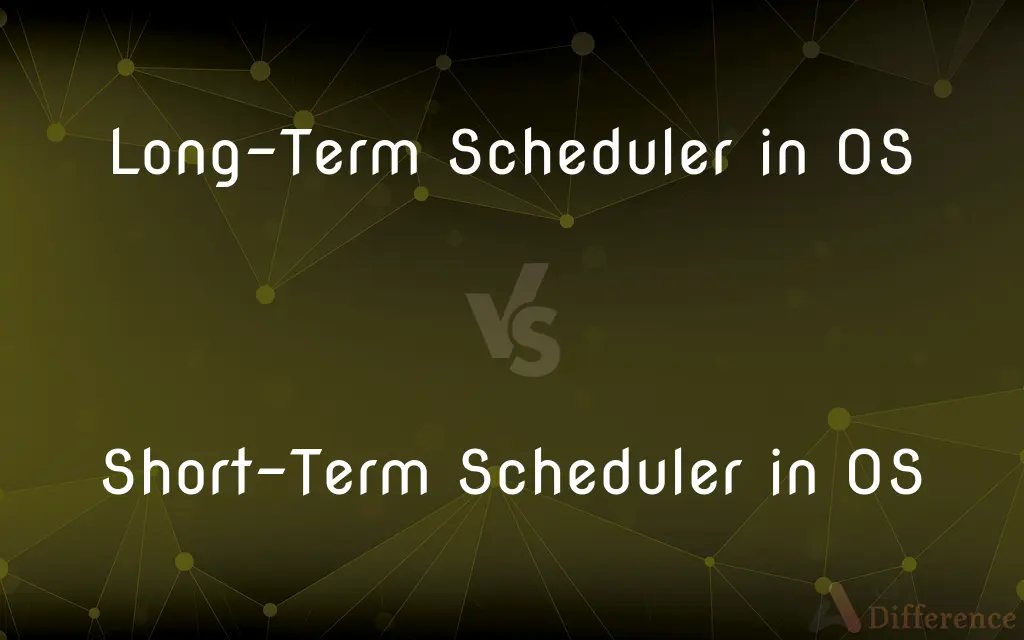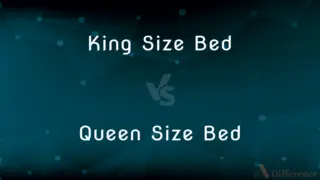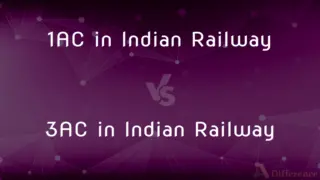Long-Term Scheduler in OS vs. Short-Term Scheduler in OS — What's the Difference?
By Tayyaba Rehman & Urooj Arif — Published on February 5, 2024
The Long-Term Scheduler in an OS determines which programs are admitted to the system for processing, while the Short-Term Scheduler decides which process gets CPU time.

Difference Between Long-Term Scheduler in OS and Short-Term Scheduler in OS
Table of Contents
ADVERTISEMENT
Key Differences
The Long-Term Scheduler in an operating system is responsible for controlling the entry of jobs or processes into the system. It decides which processes are admitted to the system for processing. The Short-Term Scheduler, also known as the CPU scheduler, makes the decision of which process in the ready queue should be executed next by the CPU.
The Long-Term Scheduler manages the degree of multiprogramming and influences the mix of CPU-bound and I/O-bound processes. Its scheduling decision is less frequent but crucial for system performance. The Short-Term Scheduler operates more frequently, executing in milliseconds, and is responsible for maintaining a balance in the effective utilization of the CPU.
In the Long-Term Scheduler, decision-making involves a significant consideration of process characteristics and system load, focusing on optimal process mix and system balance. The Short-Term Scheduler focuses on achieving efficient and effective CPU utilization, ensuring that the CPU is not idle when there are processes ready to execute.
The Long-Term Scheduler is sometimes referred to as the job scheduler. It plays a key role in determining the overall performance and efficiency of the system by controlling the number of processes. The Short-Term Scheduler, often executed frequently, is designed to provide quick and responsive process selection for execution.
Overall, the Long-Term Scheduler determines the set of processes that are candidates for execution. In contrast, the Short-Term Scheduler selects from these candidates for actual execution on the CPU, focusing on quick turnaround and efficient processing.
ADVERTISEMENT
Comparison Chart
Frequency of Execution
Less frequent, controls process admission
Highly frequent, selects process for execution
Main Function
Manages degree of multiprogramming
Chooses next process for CPU execution
Focus
Optimal process mix, system load
Efficient CPU utilization, process selection
Also Known As
Job Scheduler
CPU Scheduler
Impact on System Performance
Determines overall system performance
Affects immediate CPU efficiency
Compare with Definitions
Long-Term Scheduler in OS
The Long-Term Scheduler controls the mix of processes running on the system.
To optimize performance, the Long-Term Scheduler adjusted the process mix during peak hours.
Short-Term Scheduler in OS
The Short-Term Scheduler is also known as the CPU Scheduler.
The CPU Scheduler efficiently managed the execution order of ready processes.
Long-Term Scheduler in OS
It manages the degree of multiprogramming in an operating system.
The Long-Term Scheduler in the OS balanced CPU-bound and I/O-bound processes efficiently.
Short-Term Scheduler in OS
It aims to achieve efficient and effective CPU utilization in an OS.
The Short-Term Scheduler in the OS maximized CPU time by minimizing idle time.
Long-Term Scheduler in OS
The Long-Term Scheduler in OS decides which processes enter the system for processing.
The Long-Term Scheduler prevented system overload by limiting the number of active processes.
Short-Term Scheduler in OS
The Short-Term Scheduler focuses on quick decision-making for process execution.
With its quick turnaround, the Short-Term Scheduler responded effectively to process demands.
Long-Term Scheduler in OS
It is responsible for the admission of processes into the ready queue.
The Long-Term Scheduler in the OS introduced new processes based on current system load.
Short-Term Scheduler in OS
It operates frequently, focusing on rapid and efficient process selection.
Due to its high frequency, the Short-Term Scheduler ensured continuous CPU utilization.
Long-Term Scheduler in OS
The Long-Term Scheduler influences the overall performance of the system.
The efficiency of the Long-Term Scheduler played a crucial role in maintaining system stability.
Short-Term Scheduler in OS
The Short-Term Scheduler in OS selects processes from the ready queue for CPU execution.
The Short-Term Scheduler quickly chose the next process for execution to keep the CPU busy.
Common Curiosities
Why is the Long-Term Scheduler important?
It's crucial for controlling system load and maintaining optimal process mix.
What does the Short-Term Scheduler in OS do?
It selects processes from the ready queue for execution on the CPU.
What is the Long-Term Scheduler in OS?
It's responsible for admitting processes into the system, managing multiprogramming levels.
What is the focus of the Short-Term Scheduler?
Its focus is on efficient CPU utilization and process selection.
Can the Long-Term Scheduler affect system performance?
Yes, it significantly influences overall system performance and efficiency.
How often does the Long-Term Scheduler operate?
It operates less frequently, focusing on the overall process admission.
What happens if the Long-Term Scheduler is not efficient?
Inefficiency can lead to system overload or underutilization.
What is the frequency of the Short-Term Scheduler?
It operates very frequently, often in milliseconds.
How does the Short-Term Scheduler improve CPU efficiency?
By minimizing CPU idle time and selecting processes efficiently.
Does the Short-Term Scheduler manage system resources?
Indirectly, as it affects CPU utilization and process flow.
Is the Short-Term Scheduler the same as the CPU Scheduler?
Yes, the Short-Term Scheduler is also known as the CPU Scheduler.
Does the Short-Term Scheduler handle process priorities?
Yes, it often considers process priorities in making scheduling decisions.
Is the Long-Term Scheduler involved in process execution?
No, it's primarily concerned with process admission, not execution.
Can processes bypass the Long-Term Scheduler?
Typically, no. Processes must be admitted by the Long-Term Scheduler first.
What types of systems use a Long-Term Scheduler?
Mostly batch processing and complex multitasking operating systems.
Share Your Discovery

Previous Comparison
King Size Bed vs. Queen Size Bed
Next Comparison
1AC in Indian Railway vs. 3AC in Indian RailwayAuthor Spotlight
Written by
Tayyaba RehmanTayyaba Rehman is a distinguished writer, currently serving as a primary contributor to askdifference.com. As a researcher in semantics and etymology, Tayyaba's passion for the complexity of languages and their distinctions has found a perfect home on the platform. Tayyaba delves into the intricacies of language, distinguishing between commonly confused words and phrases, thereby providing clarity for readers worldwide.
Co-written by
Urooj ArifUrooj is a skilled content writer at Ask Difference, known for her exceptional ability to simplify complex topics into engaging and informative content. With a passion for research and a flair for clear, concise writing, she consistently delivers articles that resonate with our diverse audience.
















































